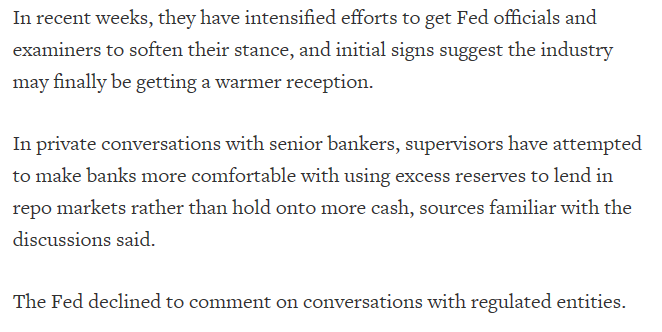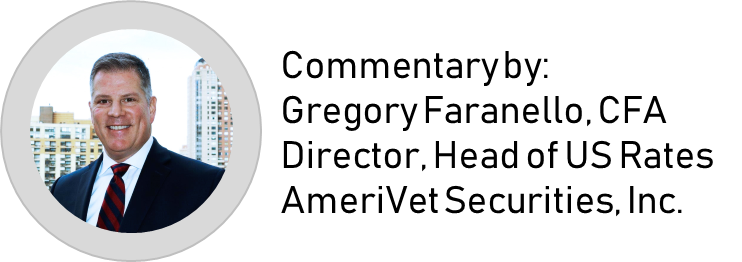Rates, Reserves and Regs

There has been an inordinate amount of opining around the recent events in the US funding markets which was triggered when the secured funding of US Treasury debt spiked to 10% in mid-September. In the end, there is no one particular answer for a confluence of events to get us there. What it did do, however, is open the discussion about important issues festering not only with Repo, but the regulators choice for Libor replacement (SOFR).
This week, on the JPM earnings call, Jamie Dimon addressed the US funding issues in typical fashion. And Bloomberg offered an opinion piece attached below with a summary of Jamie’s comments which were clear and to the point.
Jamie Dimon on Repo- What you see is not what you get (cash)
“We have a checking account at the Fed with a certain amount of cash in it. Last year, we had more cash than we needed for regulatory requirements, so Repo rates went up, we went from the checking account, which was paying IOER, into Repo. Obviously makes sense, you make more money.
Now, the cash in the account, which is still huge, it’s $120 billion in the morning, that cash we believe is required under resolution and recovery and liquidity stress testing. And therefore, we could not redeploy it into the Repo market, which we would have been happy to do. It’s up to regulators to decide if they want to re-calibrate the kind of liquidity they expect us to keep in that account. I think a lot of banks were in the same position, by the way.”
Jamie Dimon Specifically on Regs
“We believe the requirement under CLAR and resolution and recovery is that we need enough in that account so that if there’s extreme stress during the course of the day it doesn’t go below zero. To go back to before the crisis, you go below zero all the time during the day. So the question is, how hard is that of a red line…?
That will be up to regulators to decide, but right now we have to meet those rules and we don’t want to violate what we told them we are going to do.”
What is CLAR?
In 2012 the Federal Reserve launched the Comprehensive Liquidity Assessment and Review (CLAR) for firms in the Large Institution Supervision Coordinating Committee (LISCC). Similar to the Comprehensive Capital Analysis and Review (CCAR), CLAR is an annual assessment including both quantitative and qualitative components, overseen by a committee of liquidity ‘experts’ at the Federal Reserve.
With CLAR, Fed supervisors assess the adequacy of LISCC portfolio firms’ liquidity positions relative to their ‘unique’ risks, testing the reliability of these firms’ approaches to managing liquidity risk. CLAR provides a regular opportunity for supervisors to respond to evolving liquidity risks and firm practices over time.
Some Context of the Evolving Regulatory Landscape below:
November 20, 2014 Liquidity Regulation Governor Daniel K. Tarullo
“Under the enhancement of the international G-SIB surcharge being developed by the Federal Reserve, the formula used to set risk-based capital surcharge levels for U.S. G-SIBs would incorporate each U.S. G-SIB’s reliance on short-term wholesale funding.
Greater reliance on short-term wholesale funding leaves firms more vulnerable to runs that impose externalities on the entire financial system. Requiring higher capital levels at such firms will improve their chances of maintaining access to market funding in periods of stress by providing greater assurance of their solvency to counterparties.”
So, what has been the Fed’s response on regulatory versus Repo?
At the September press conference, and following the recent Repo spike, Chairman Powell was asked specifically about the role of the post-crisis regulatory changes and recent funding levels. His answer was very clear: the regulations are in place for a reason and we’d be more inclined to increase reserves. His actions last Friday certainly backed up his words.
Since the mid-September Repo spike and following the September meeting, we have been vocal about the Fed’s balance sheet and likely expansion. QE, or not QE, we have our view but it seems almost pointless to argue it at this point. Too much back and forth.
The reality is, the Fed does not know the exact level of reserves necessary to conduct their new policy framework under the ample reserve initiative. They have essentially admitted this. So, the process becomes very much a ‘trial and error approach’, with the mid-September debacle the error to finally trigger a response. Somewhat sad, but true.
New York Fed President Williams from Yesterday
Money Markets and the Federal Funds Rate: The Path Forward
October 17, 2019
“As the level of reserves has come down, we stepped up our monitoring of the effect of reserve levels on interest rates. The level of reserves consistent with “ample” is inherently highly uncertain, so we have been actively looking for signs that reserves might be growing scarce”
Actively looking for signs of stress that reserves may be growing scarce?
Full text of Williams’ speech below:
https://www.newyorkfed.org/newsevents/speeches/2019/wil191017
Following Williams’ speech he was asked, like Powell, about the role of the regulatory environment and the US funding challenges. And the timing of the speech in conjunction with Jamie Dimon’s comments earlier in the week align now for an interesting showdown:
In a nice summary article from MarketWatch (10/17)

It’s an interesting approach from the Fed. The Standing Repo Facility still sounds like a ‘discussion point’, leaving the increase in the reserve numbers close to the only game in town. Some talk of a ‘standing’ lending facility as well. Certainly, not new concepts.
Additionally, within the discussion of Repo and reserves, the Fed still sounds only concerned with the biggest banks in the US. The concentration of activity, cash and risk came to light in mid-September. Simply increasing aggregate reserves will not, in and of itself, resolve the issues in the funding markets in our view.
So, if reserves are the only game in town. And the reserve adjustment will cover the unintended consequences of regulatory change as Williams alludes to, then it would seem a softening of the ‘usage’ of the “ample reserves” v cash would be a necessary pathway going forward.
In a Reuters article from yesterday (The Banks v Fed)

“On the surface, there still appears to be a disconnect between the events of mid-September, the Fed’s actions to date and the intimated way forward.”
With year-end quickly approaching, this story is not going away anytime soon. And lastly, Williams mentions SOFR in his speech with an attempt to quell the critics and recent volatility. Ultimately, in normal times, secured funding of US Treasury collateral needs to function properly. Now is the time to get busy on legitimate solutions while leaving the defensive posture behind.
And end-user Libor participants have questions. Telling the market: “don’t worry about spikes in secured funding, we use an averaging methodology with SOFR”, is not acceptable. Secured funding of US Treasury debt trading at 10% is not just a spike. Confidence, and more importantly understanding, are critical factors as the regulators push the end-user toward the use of SOFR as the Libor replacement. Simply put, the Fed has not provided sound leadership on this.
The Markets
The markets are trading “as if we’ve heard this story before”. On one hand there’s a touch of optimism (10-year yields back a touch above the middle of the range), yet on the other hand a reluctance to fully embrace the mistakes of the past as ‘talk is cheap’. The market is ready for outcomes.
Boris still needs parliamentary backing and Donald the fine print on a substantial Phase 1 deal. Just small details for the market but there’s hope for now.
This has been a long haul for the markets. Over the past year, we have seen one of the biggest whipsaw events in central bank history. And mainly off the back of a continued inability for the sovereign side of our global economy to get its store in order.
For the Federal Reserve, the Potus provided a shot in the arm in 2016. The hope of a pro-business mindset behind the winds of excessively low interest rates for many years. And by 2019, it became blatantly clear that global resets have economic repercussions and tailwinds can quickly shift to headwinds. Big headwinds.
For the UK, it’s been akin to suffering. Good, bad or indifferent: clarity is a good thing in life. And even as we look to the business investment side of where things have clearly slowed, smart people in life will adapt around change so long as the change happens.
This has been a long painful process over the past 3 years, and a solidified outcome despite adjustments already made along the way to account for the worst, will be eventful for all parties involved and certainly the markets. The UK is not insignificant.
Over the past few days, we have highlighted the key levels in global rates. The markets await. In looking at 10-year US rates, we sit roughly in the middle of the recent range with many long end Euro rates at their upper end. The rate markets, in our view, are ‘ready’ to make a move higher in yield but the fine print needs to be inked for this to happen.
Chart on 30-year Euro Swap Rates

From a bigger picture view, rates are still at extremes. From a local perspective, however, we could easily find a reason to pivot back lower from here. In the end, it leaves us with thoughts of optimism and the feeling rates and curve could move higher and steeper yet sitting in the middle of the long end US range with a bunch of very important unanswered outcomes. Right now, the expert opinions on the numbers for the Brexit vote fall roughly around 50-50. Not great risk reward in the middle and upper end of the recent ranges.
It’s late in the year folks. No reminder needed of last year, this time. The hope of a deal: China, Brexit, etc. is enough to move 10-year yields off the lower end of the range (1.50 to 1.75%), but we’ve been expressing the view that the market needs some real, concrete progress. And that what’s been done will not be undone with the swipe of a pen.
October Fed Meeting
The Fed is watching. If anything, the Fed’s ability to finally to act on the balance sheet will allow a more objective view on whether the need for absolute funding levels to come down again is warranted at the end of this month.
We have been in the camp that the bar is higher for future rate cuts after two notched under the Fed’s belt. Even still, it’s hard to imagine that, if the dust doesn’t settle with the events of the last 7 days, the Fed sits on their hands in the middle of a risk management effort. You simply don’t turn risk management off without improvement in the risk factors. And as NY Fed Chairman Williams indicated yesterday, the risks from September are still the risks of today. True.
It’s messy out there still. And although we don’t feel lower rates will resolve it entirely, sitting on your hands is not the best course of action either. We’d love nothing more than to see some small, yet substantive progress on the trade front, Brexit and geopolitical tension. Right now, it continues to present very uncertain and tenuous. Even if these issues move to a better place in the coming weeks, prudent risk management would lend itself to taking more insurance right through it. As Bullard has indicated: “we can always take it back.”
The question for the Fed right now is: has anything really changed between the September meeting and now?
Risk management mode and the risks that existed when the Fed began its mid-cycle adjustment are very much alive. If anything, the biggest changes since September are signs of weakness now in the US manufacturing and consumer data. All things considered, the market skewing its pricing for another cut this month makes sense. Although the recent Fed speak has been mixed, there has been daylight for more cuts in every communication from Powell’s inner circle.




